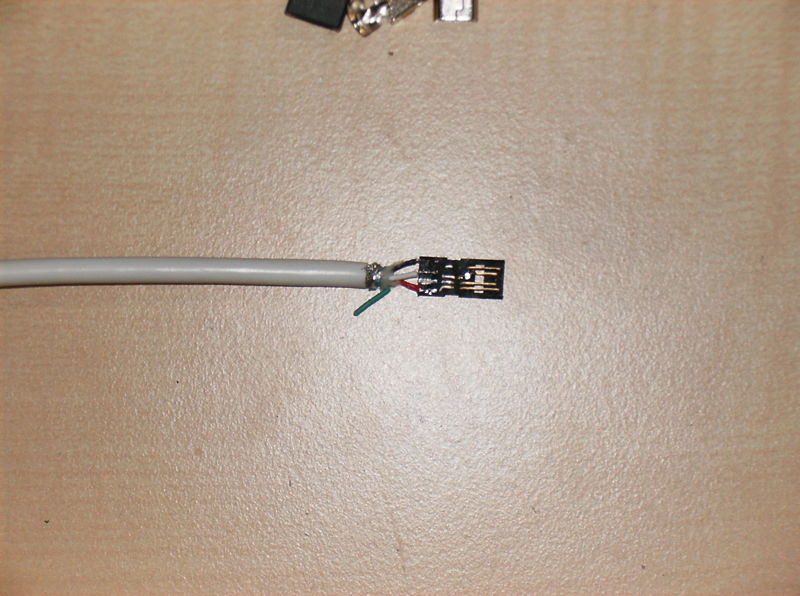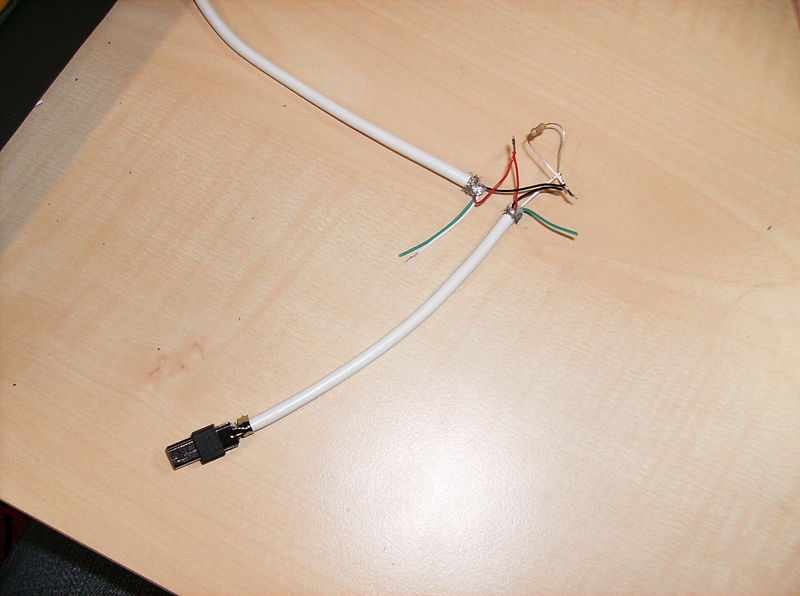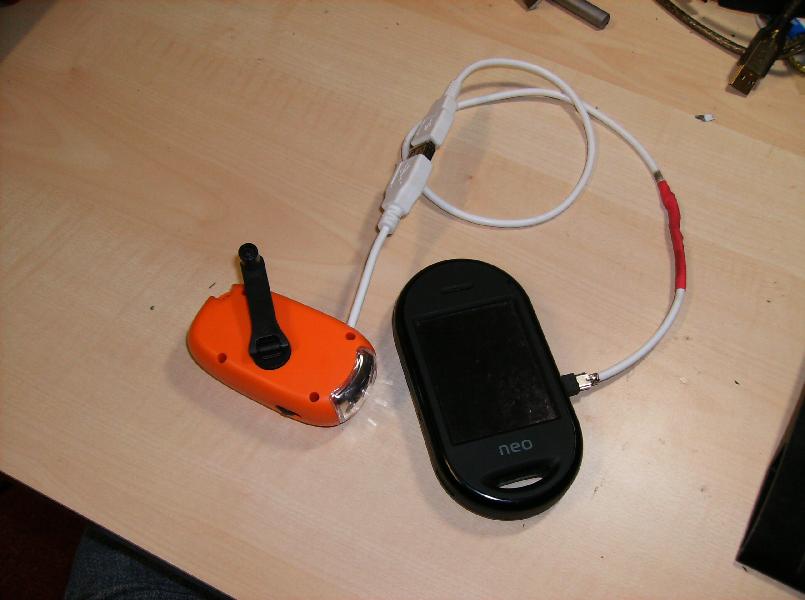User:Blutsauger
From Openmoko
Contents |
FR as host on active hub
This is my latest artwork:
Mobile work-place ;) Freerunner beeing charged from a modified USB hub using 5 AA batteries.
Full keyboard, mouse and external HDD connected!
Internet access wia UMTS dongle.
A special holder places the FR into a reflection-free angle.
Note the TUX penguin, that I have manually glued on the 'Windows-Keys'!
I have bridged the output power supply of the USB slots in the USB hub back to the 'input' line (where the FR plugs in). With a manual switch I can turn on/off this power feed. This might be some good luck that the good piece didn't blow off - it's a 20EUR DLINK hub.
The USB gender changer (female/female) can be bought for example at the big 'C':
http://www.conrad.de/goto.php?artikel=974822
The power supply are 5 AA NiMH accus, which deliver around 6.5V when fully charged. This is about the same voltage the comes from the external AC/DC power plug.
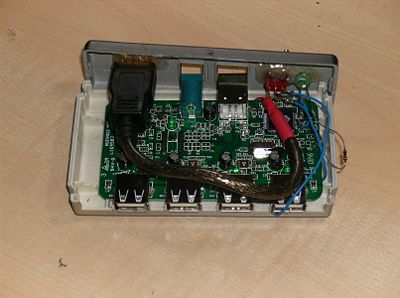
|
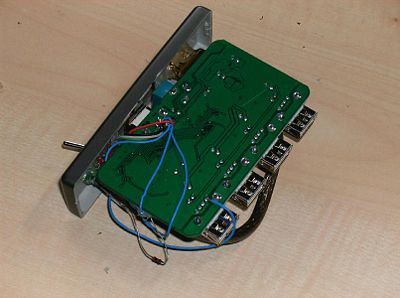
|
Note the single blue wire on the bottom right of the right image. This is all it needs. The rest is just fun like an additional switch with a LED to turn power-feed on and off and another Type-A USB slot, so that I don't need the genderchanger and the Type A/B converter any longer as one can see it in the topmost image.
For soldering hints, please look at
http://en.wikipedia.org/wiki/File:USB.svg or http://en.wikipedia.org/wiki/Usb
ATTENTION:
After I have soldered the second USB connector (the black thick cable on the left image), the hub did not work any more on a regular PC, although it still worked on the FR. So my assumption is, that it is not broken, but maybe the USB signal reflects on the open-ended cable. I will invastigate further.
Try this at your own risk! Be prepared to inflame your USB hub, power supply or even your phone!
(You have been warned...)
More images:
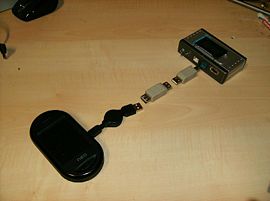
|
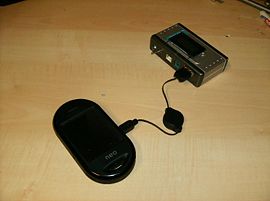
|
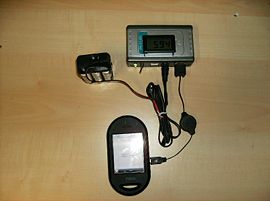
|
From left to right:
Usual way to use the FR as a USB hub (you need 3 different adaptors)
'Short' way with self-soldered USB connector into the hub, which makes it unusable for PC's, though!
Integrated voltage meter in the USB hub, displaying either the HUB's own power supply voltage, or the voltage delivered from the FR to the hub, depending on the small switch that I have built in. LED indicating current direction.
1000mA power supply
To set the FR into the 1000mA charge mode, a special USB cable is required which bridges the 'Id' pin of the mini-USB plug to ground with a resistor of 47KOhm (See USB_charger). Unfortunately, all usual USB cables that connect a PC with a device dont lead out that Id pin. I bought a mini USB plug, but that also had no connector for the Id pin, so I had to make some micro-mechanics:
I cut the Data+ pin (3rd pin from top) and shortened the Id Pin (2nd form above) with the Data+ line, which is the white wire on the image. Note the small soldering poing, which bridges the cut Pin Data+ (wire only) with the 'Id' contact (to phone).
Then I put the 47KOhm resistor between ground (black) and the 'stolen' Id pin (white).
So far this works pretty good. But the mini USB connector is not the best. It has only flat contacts and fits very loosely in the FR USB slot, so very often there is a bad contact. I got this part from Conrad but would suggest buying something of better quality.
Charging crank
After various attempts to charge the phone with a bicycle dynamo (there are also some hints on the Wiki, I will add links later), I thought about charging the phone by manual power. So I stole the small lamp of my daughter which charges a 3.6V NiCd battery by turning a crank.
I replaced the battery by a 1000uF elko because I didn't want to charge another useless battery. The elko should buffer and smooth the output voltage:
So far this works pretty well, at least in theory - It is surprising how much strength one must spend to get about 300mA current. This is about what the good piece can deliver. Of course, the charging time stays the same: about 2 hours for a complete exhausted battery. So please imagine to turn the crank at full speed for 2 hours! This was a nice try, and maybe usable for emergency situations but not for daily live!
Using alternate browsers
Midori is nice...but not a fully usable browser. And loading pages over cellphone network is pretty slow. Therefore I use a ssh tunnel to a X-server at home and look at it via vnc. (I don't explain how to set-up an ssh account through dyndns here...)
at home type:
vncserver :30 -depth 24 -geometry 1280x1024 DISPLAY=:30 firefox &
on the FR in a first shell:
ssh -L5930:localhost:5930 myaddress.dyndns.org
and in a second shell:
vncviewer localhost:30
Adding swap space on mmc card
In SwapSpace is descriped how you add a swap file on filesystem. This seems somehow complicated to me. I wanted to use my microSD card for swapping (it doesn't matter if it gets broken after 2 million read/write accesses). Also, I don't want the mmc card formatted with VFAT anyway, so I made a new partitioning:
/dev/mmcblk0p1 1 5129 500075 82 Linux swap / Solaris /dev/mmcblk0p2 5130 81820 7477372+ 83 Linux
and added in /etc/fstab:
/dev/mmcblk0p1 swap swap defaults 0 0
doing a
mkswap /dev/mmcblk0p1
once and a reboot and we're done.
See what 'top' says: the internal 128MB memory is almost always completely exhausted, with just one or two applications running. With 512MB swap space I can use Midori, tangoGPS, several terminals, the settings pages and so on all at the same time.
Mem: 120856k total, 116364k used, 4492k free, 172k buffers Swap: 500064k total, 67696k used, 432368k free, 71764k cached
Contact me
openmoko
at
edv-buero-lehner.de


